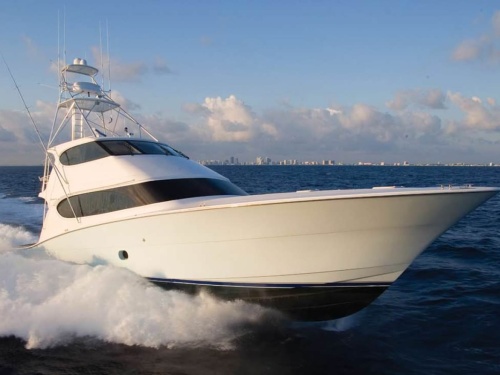Access More Boat Tests
Already have an account? Login
Hatteras GT 70 (2016-)
2 x 2600-hp MTU
Brief Summary
Hatteras has been no stranger to large offshore convertibles. Its previous convertible flagship was the GT 68 and the company built and launched 51 of them. But things change and consumer needs evolve as well. The new management at Hatteras recognizes all of that and upped its game considerably in what is the largest explosion we have ever seen in new models in the gold-plater class. Not only is Hatteras launching lots of new models, but in the case of the GT 70, she has caught the eye of veteran anglers who know a Carolina via Palm Beach thoroughbred when they see one. Not only is the new GT 70 big, and outfitted with the latest and finest of everything, but she is also fast.
Key Features
- Built on a variable deadrise bottom with a sharp entry
- Powered by standard twin CAT C-32A diesels or optional MTUs
- Fuel capacity of 2,140 gallons
- Two 21.5 kW diesel generators
- Features a gourmet galley
- Accommodations include five staterooms and four head accommodations
Test Results
| RPM | MPH | Knots | GPH | MPG | NMPG | STAT. MILE | NM | dBa |
|---|---|---|---|---|---|---|---|---|
| 550 | 8.3 | 7.2 | 9 | 0.9 | 0.8 | 2490 | 2165.2 | 77 |
| 1000 | 14.1 | 12.3 | 37 | 0.4 | 0.3 | 1029 | 894.7 | 83 |
| 1250 | 17.8 | 15.4 | 63 | 0.3 | 0.2 | 761 | 661.5 | 85 |
| 1500 | 24.3 | 21.1 | 90 | 0.3 | 0.2 | 728 | 632.6 | 86 |
| 1750 | 31.5 | 27.4 | 128 | 0.2 | 0.2 | 664 | 577.8 | 91 |
| 2000 | 38 | 33 | 178 | 0.2 | 0.2 | 576 | 501.2 | 92 |
| 2250 | 44.1 | 38.3 | 216 | 0.2 | 0.2 | 551 | 478.8 | 91 |
| 2450 | 47.2 | 41 | 262 | 0.2 | 0.2 | 486 | 422.5 | 92 |

Specifications
| Length Overall | 73' 8'' / 22.45 m |
|---|---|
| Beam |
21' 4'' 6.5 m |
| Dry Weight |
120,000 lbs. 54,431 kg |
| Tested Weight |
130,620 lbs. 59,248 kg |
| Draft |
5' 0'' 1.53 m |
| Deadrise/Transom | N/A |
| Max Headroom | N/A |
| Bridge Clearance | N/A |
| Fuel Capacity |
2,140 gal. 8,101 L |
| Water Capacity |
330 gal. 1,249 L |
| Total Weight |
130,620 lbs. 59,248 kg |
Acceleration Times & Conditions
| Time to Plane | 7.2 sec. |
|---|---|
| 0 to 30 | 8.3 sec. (0to20) |
| Ratio | N/A |
| Props | N/A |
| Load | 2 persons, 1/2 fuel, 1/2 water, 50 lbs. of gear |
| Climate | 89 deg., 87 humid.; wind: 15-25 mph; seas: 3-5 |
Engine Options
| Tested Engine |
2 x 2600-hp MTU |
|---|---|
| Std. Power |
2 x 1900-hp Cat C-32A diesel |
| Opt. Power |
Not Available |
Captain's Report
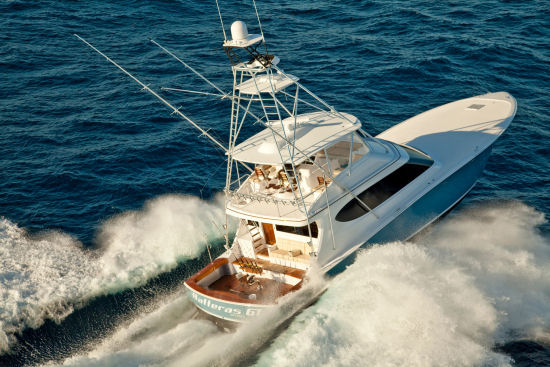
Overview
The new GT 70 is the largest and most formidable big game weapon in the Hatteras stable, and one might ask if there is any need for something larger. With a huge fighting cockpit, a main salon big enough for a square dance and five staterooms, this vessel can accommodate the party and afterguard for most any big game hunt. The GT 70 comes with larger engines and a fuel capacity of 2,140 gallons (8,101 L). Her joinerwork and fit-and-finish are second to none, and the same can be said of a myriad of other details. That is one of the advantages of having the latest model in class. In a word, no expense has been spared to build a boat that is absolutely a killer at her mission.
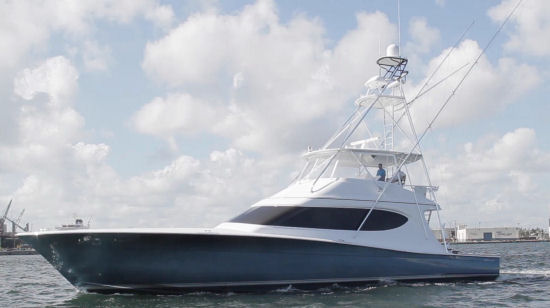
Distinguishing Features
Wide Beam.
At 21’4” (6.50 m), she is the widest convertible in class. That one design decision affects nearly everything about this yacht – from the cockpit, to the accommodations, to her stability and draft, and much more.
Speed.
Despite her beam, our test boat broke the 40-knot barrier in 3’ to 5’ seas powered by twin MTU 2600-hp diesels.
Carolina/Palm Beach Styling.
From her high bow to her low fighting cockpit, to her tumblehome stern quarters, the GT 70 is as graceful as any custom convertible on the market.
Painted Hull.
Hatteras was on to this important construction detail decades ago, and still, most builders eschew the added trouble and expense involved with painting over gel coat. But it pays off for the owner in far lower maintenance and a longer-lasting high-gloss finish.
Lightweight with Strength.
At 120,000 lbs. (54,431 kg) dry she is certainly on the light side in class, and Hatteras has done that without sacrificing strength. For example, her bottom is solid fiberglass, not cored, to be more puncture-resistant.
Lower Draft.
Because she is relatively light, has a 21’4” (6.50 m) beam, and has propeller tunnels, she draws only 5’0” (1.53 m). This is good news for people who want to park their pride-and-joy in front of their house in a moon tide.
Superior Floor Layouts.
With more beam to work with, Hatteras designers have been able to make staterooms larger and the main salon and galley far more functional.
Features Inspection
Cockpit
This is a fishing machine, first and foremost, and the focal point of the action is in the cockpit. On the Hatteras cockpit, there is a premium level fighting chair ($54,415 including 3 ladder-back chairs on flybridge), fully adjustable and loaded with rod holders. The chair is bolted down to a fighting deck that we measured 8.5’ x 16’ (2.59 m x 4.88 m) or 136 sq. ft. (12.64 sq. m). Add the mezzanine, its step up, and adjacent consoles to the bulkhead and the cockpit measures 200 sq. ft. (18.58 sq. m). Teak decking is throughout ($44,100) and both caprails ($27,692) and bulwarks ($20,958) are unfinished teak.
The shaded mezzanine seating makes a perfect place to relax and watch the lines and the extended overhead at 8’6" (2.59m) off the mezzanine deck provides welcome protection. Rather than just tossing in seating and calling it a day, Hatteras has stepped up its game and focused its attention on making this area comfortable. With plush cushioning these seats are unusually comfortable for this location and armrests to both sides have integrated beverage holders along with the “floating” armrest that can be moved about as desired. The teak cockpit decking alone is optional ($24,136).
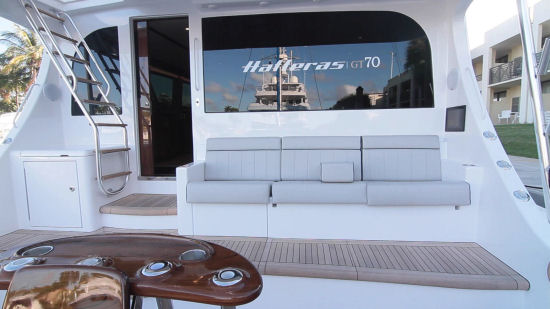
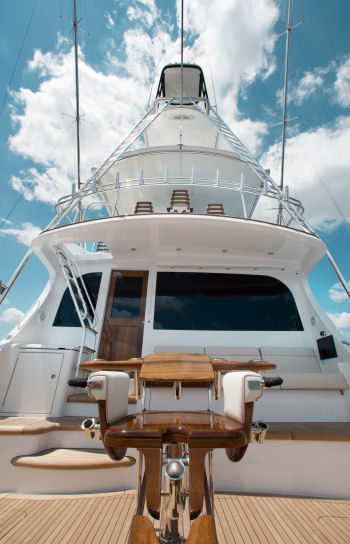
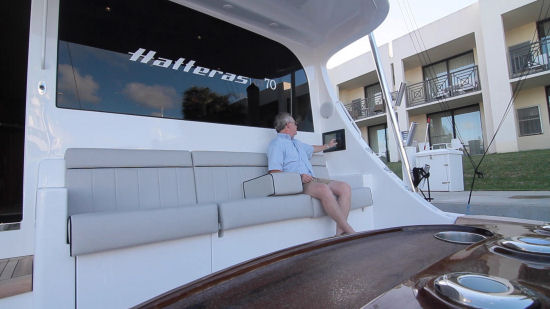
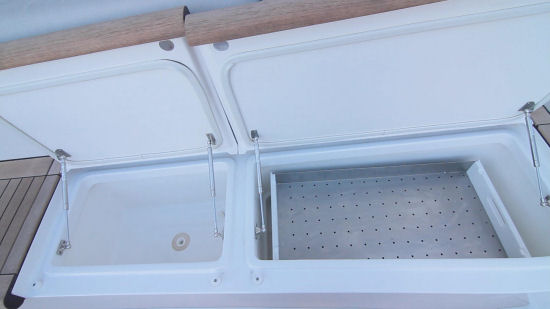
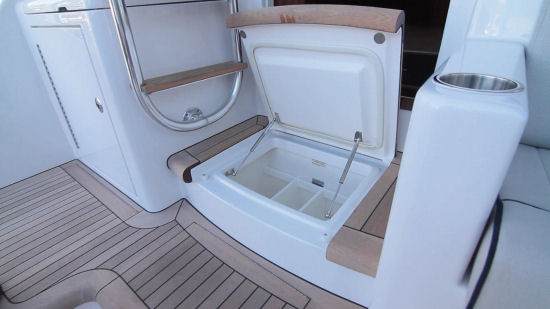
Of course the main benefit of this elevated area is the ability to keep non-essential personnel out of the way when the action starts while still being able to watch it all go down. It also keeps baits in the insulated boxes out of the sun. Our test boat had the optional cockpit air-conditioning ($10,658) over the seat and a NAV repeater was to the starboard bulkhead.
Storage is everywhere… under the seats, under the deck. There’s even an icemaker to starboard just above an insulated storage compartment in the deck. This option requires shoveling the ice into the deck hold, and with an optional Eskimo icemaker ($16,163) Hatteras will accommodate those who want the ice to flow directly into the fish lockers, but keep in mind that this option will contaminate all the ice, not just the ice that is chosen to go in there.

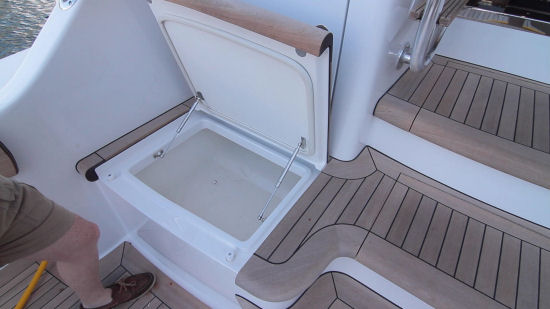
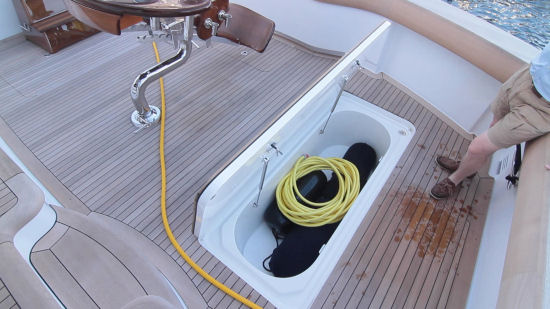
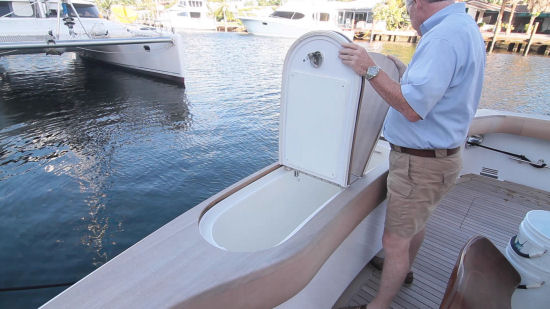
The transom tuna-door is a little difficult to operate but still doable. It requires reaching under the coaming, releasing the latch, lifting the heavy top piece, releasing the stainless lever on the door and finally opening. And there is no latch to hold it in the open position so mind the fingers in a rolling seaway. All of this is easily fixed, and we are sure that Hatteras will.

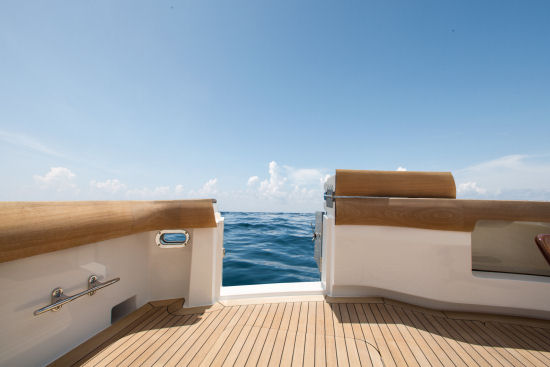
Flying Bridge
In the standard configuration, the flying bridge is accessed from a ladder in the cockpit. It’s not the most comfortable way to access an upper deck but it is far better than traditional forward-facing ladders which are steeper and can be risky in a brutal offshore seaway. It not only provides adequate access but it also doesn’t impinge on the usable space below.



Three Versions.
The test boat we were on had the standard configuration, one of three available. A center console is mounted aft, well within view of the fight in the cockpit with the captain well positioned to maneuver the boat in the most advantageous manner to bring said fight to a happy conclusion. Four 19” (48.3 cm) displays grace the instrument panel providing a wealth of selectable information. Our panel even had the FLIR camera proudly showing in one screen.
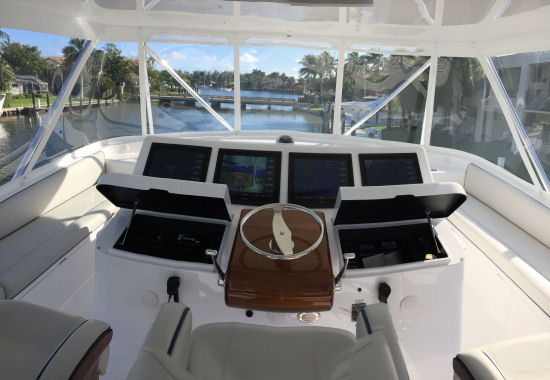
Seating
Three high-end ladder-back seats at the helm were finished to perfection and allow the captain to have a couple of observers assist in the navigation. The center captain’s chair is slightly elevated from the other two and while providing excellent sightlines for 360-degrees, the view of the cockpit takes necessary priority over the direct view of the bow. This is an appropriate tradeoff as the bulk of the action will be away from the dock where that view of the bow becomes more inconsequential. If one must see the entire perimeter, may we suggest the elevated position of the tower? More on that later. The remainder of the seating wraps around the perimeter of the bridge deck and still, more is ahead of the console for guests to face each other when socializing. Seatbacks to the side lounges have reversible seatbacks so guests can choose to watch the view ahead or behind. All seats have storage underneath and Hatteras included two freezers in this space. While the freezers are a welcome addition, particularly for anglers heading to Central or South American fishing grounds. We suspect that Hatteras would be happy to install something along the lines of a wet bar for those who want to put the emphasis on entertaining rather than long-distance travel.
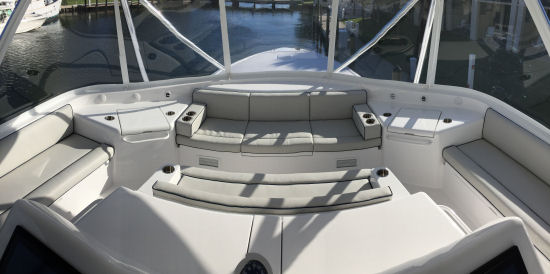
Enclosed Flybridge Option
Two enclosed flying bridge options ($280,260) are offered, one with an interior staircase and one with only the exterior stairs. With either enclosed option, the concern about visibility to the cockpit is duly addressed. An aft control station is fully fitted and lies under the shaded protection of the extended overhead. An aft-facing observation bench seat for two is just inboard of it. Palm Beach style controls allow for the captain to face aft while backing down on a fish. Trolling valves at all stations allow for a clean wake while maintaining steerageway. A full electronics package can be flush mounted to the panel. Inside the luxury continues, mirroring the appointments below. The fully air-conditioned bridge offers plenty of seating and outstanding visibility, particularly from the helm that is now mounted far enough forward for a view of the bow.
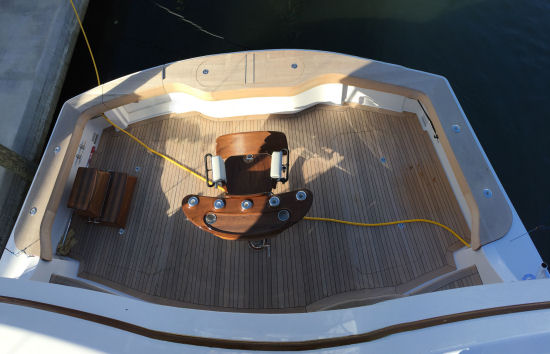
Tower
202 Square Miles.
We’d certainly be surprised if Hatteras didn’t add a tower to its flagship and it didn’t disappoint. Hatteras turned to its long-standing outfitter, Pipewelders, to fabricate an optional tower ($215,400) worthy of the GT 70. While no exact figures were immediately available, the Pipewelders representative that we spoke to estimated the tower height at 40' (12.2 m), which means that the elevation brings the distance to the horizon out to nearly 8 miles. In other words, from that upper helm we can scan an area of 202 sq. miles around the boat (pi x 82). If there are birds even thinking about working a school of fish, the captain will know about it.

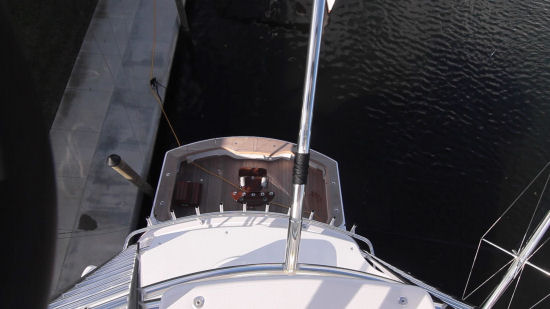
A full electronics package is offered ($171,146) to allow complete navigation from this position. The white powder coating of the rest of the tower, giving way to non-reflective black at the top enhances visibility and all can be finished in clear coat ($4,820). Choose from either a leaning post or bench seat. Plumbing runs from the water pump to the tower to make cleanups easier. No need to carry a hose up the ladder as one is fitted to the connection already. As for the outriggers, those are hydraulic, deploying at the touch of a button, and at 50’ (15.24 m) they’ll put out another 100’ (30.5 m) spread, even after figuring the aft swept angle along with the 21’4” (6.50 m) beam separating them.
Salon
As soon as one steps through the electrically opening sliding door, the feeling of luxury becomes almost overwhelming. Hatteras stuck to its roots and kept the classic teak look that, in this case, is dressed in a high-gloss finish. All hardware is polished chrome. Clean lines and exacting fit-and-finish are complemented by modern touches throughout that make this traditional nautical look have a contemporary flair. Headroom measures 7’ (2.13 m)
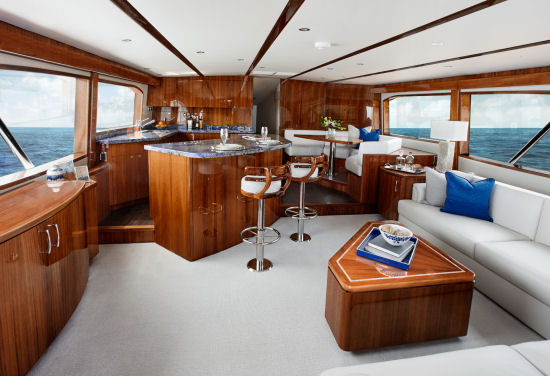
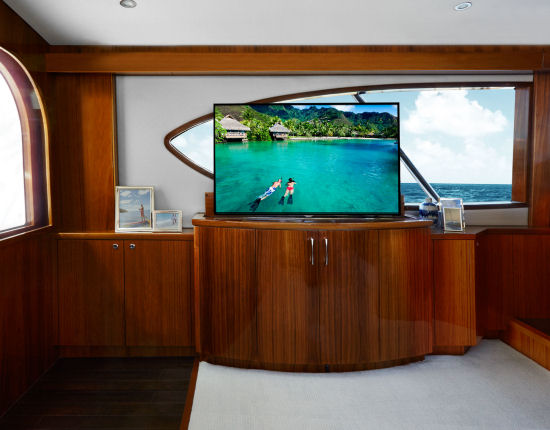

Wide Beam.
The salon area is large -- thanks to the boat’s 21’4” (6.50 m) beam -- and open to provide plenty of room for anglers or a large cocktail party when at the marina. This area is carpeted which separates it from the slightly raised galley deck. The L-shaped sofa wraps around the rear starboard section with the entertainment center in a cabinet to port that includes a TV on an electric lift, automatically actuating when the power is turned on. A custom salon table ($1,759) has a top that lifts and moves laterally to become an impromptu dining area.
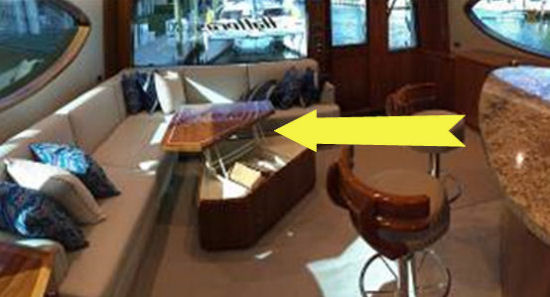
The salon is carpeted throughout with the exception of the entry with synthetic wood flooring. Overhead, fabric-ceiling panels are highlighted with wood accents matching the cabinetry. An icemaker is at the end of the sofa and rod storage is underneath the cushions.
Galley/Dinette
The galley is placed forward and to port on the main deck with the dining settee set opposite to starboard. An island, with two fixed pedestal stools, serves as a bar/dining counter and houses the multiple refrigerated/freezer drawers. Headroom measures in at 6’7” (2.01 m)
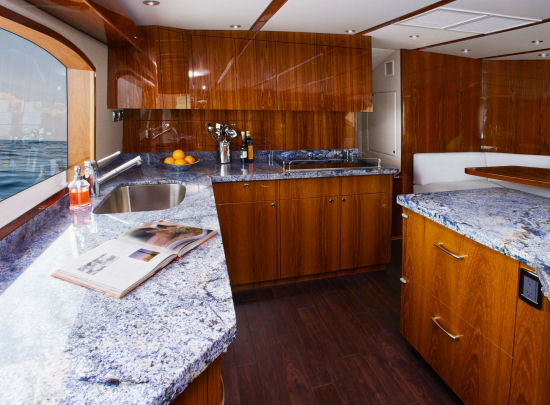
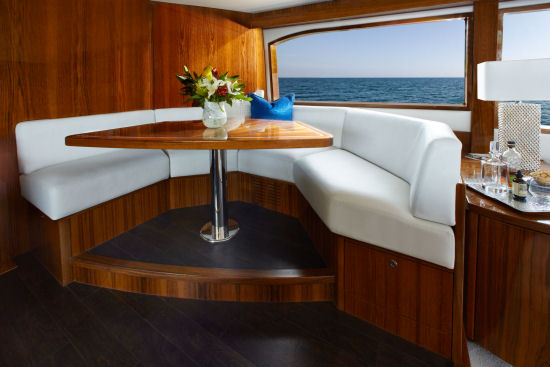
Decking
is low-maintenance synthetic wood. This is a material that all of the best builders are now using because of its durability and ease of repair. A fabric headliner is installed in tracks for easy removal to access wiring. All countertops are granite and wood inserts on appliance fascia match the wood cabinetry. A garage-door style cabinet conceals the microwave above. There’s a four-burner ceramic cooktop. The stainless sink is fitted with a garbage disposal and there are both AC and DC lights throughout.
Accommodations


Companionway
It’s rare that we add a section for the companionway in a report but this one does have some notable features. The carpeting we saw above continues here, as does the fabric overhead. The stairway is illuminated with courtesy lights. To port, just past the guest stateroom is a doorway housing the stacked washer and dryer. Then beyond is the day head with a walk-in shower. All doors are solid wood with curved headers, decorative inlay and easy close latches.

Below decks
The GT 70 features a five-stateroom/four-head layout, as standard. Once again, the GT 70’s prodigious 21’4” (6.50 m) beam pays off in extra room to make even the smallest cabins actual staterooms. All cabins have high overheads that all will find comfortable and roomy. Owners and VIP guests will have the luxury of larger berths while guests and crew will get their choice of smaller cabins, all equipped with Pullman-style berths. Hatteras chose to keep the smooth lines of the GT 70’s profile and not install hull side windows. In this manner, the integrity of the hull is left intact, and that’s a paramount consideration for a boat that is designed to take a pounding. Besides, the staterooms will likely only get used at night… when it’s dark.
Special Rod Storage.
Of course as roomy and comfortable as the staterooms are, some will consider another room the “best in house”. We’re speaking of the dedicated rod locker ($2,716) in the passageway just abaft the forward VIP stateroom. This cedar-lined locker is supplemented with overhead rod storage just outside the door and both serve to remind us that Hatteras never forgets what the principle mission of this battlewagon is… Fishing.
Staterooms
All staterooms have the same features of carpeting, fabric overhead and bulkheads, cedar-lined storage, optional TVs ($1,765), individual HVAC controls and full-length mirrors.
The Master.
At the bottom of the stairs, and just to starboard, is the master stateroom. This en suite stateroom has the king-sized berth mounted athwartships against the outside bulkhead. The cedar-lined walk-in closet is to one side of the berth while the head is forward. Headroom is 6’9” (2.06 m).

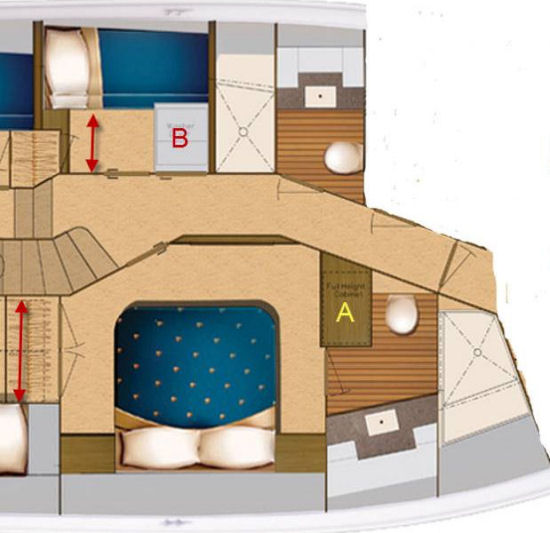
Master Head.
First of all, it is big enough for two people to use at the same time. Like the galley, the head has synthetic wood flooring but this time it is trimmed in hardwood baseboards. Countertops are marble with a backsplash. A mirrored cabinet is above the sink and the base cabinet matches the décor of the rest of the yacht. The toilet flushes with freshwater, and an indicator light shows when the holding tank reaches three-quarters of its capacity.
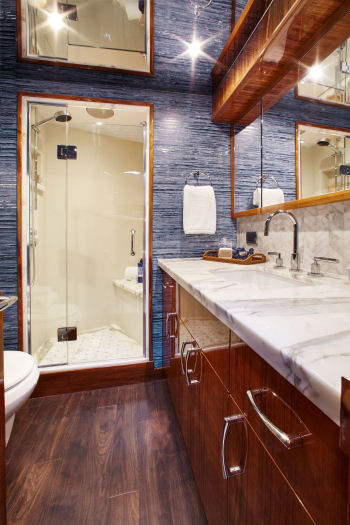

The VIP.
Fully forward is the VIP stateroom with an island berth and the usual accommodations for storage. Obviously this space is somewhat limiting, but Hatteras has made the best of it by making this stateroom unusually large. By not jamming the cabin as far forward as possible, it has a relatively wide forward bulkhead. This allows the head of the bed to be wider than the foot, rather than the diamond-shaped forward bed we often see in class. Even though the 21’4” (6.50 m) beam does not extend this far forward, the bow is still much larger than it would be in a narrower boat, which allows the VIP stateroom to be wider than we often find. This means more clearance between the foot of the bed and the aft bulkhead. In the drawing below, note the clearances and the square footage of deck space. Also, the designers used the considerable Carolina flare of the hull sides to install much-needed cabinets port and starboard.
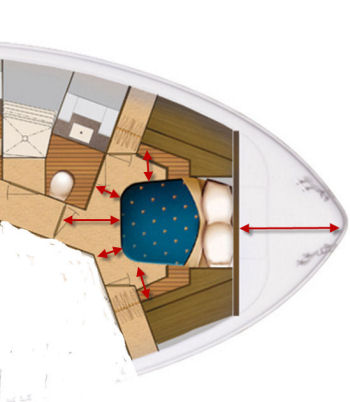
Guest Cabins.
Across from the master, and again behind the stairs, are the three guest staterooms. The two aft staterooms serve as crew quarters, both being separated by a head. A separate door to the aft section of the head leads to the engine room. All guest staterooms have over/under Pullman berths, expanding the usability of the sleeping areas. Mirrored ceilings are offered as an option ($1,765).
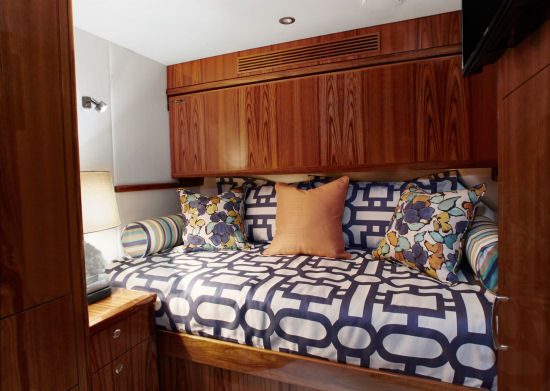
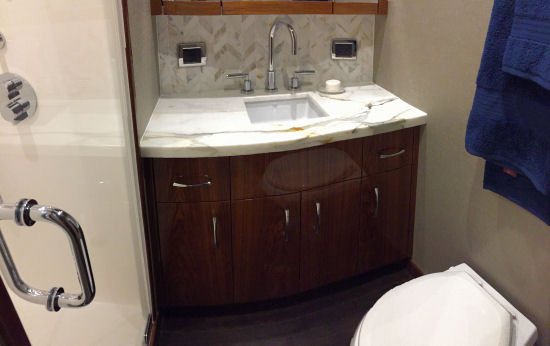
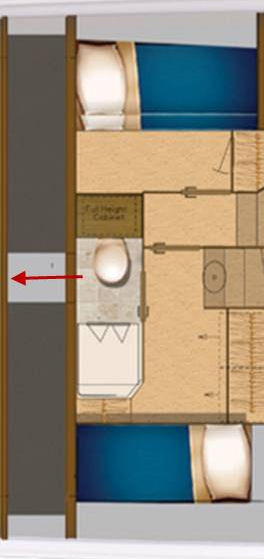
Crew quarters are aft and are separated from the main accommodations section of the boat, something not always possible even on boats this size. Both cabins can have Pullman berths meaning four can sleep here. When on a family outing our guess is that the kids will love to hang out here.
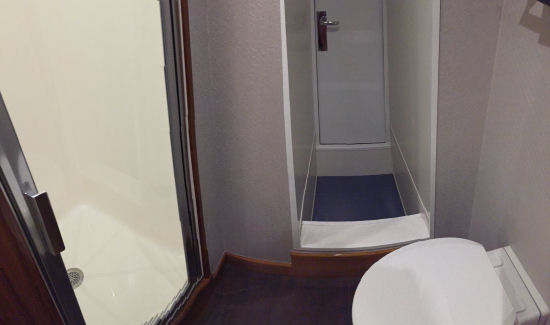
Engine Room
The engine room is finished in gleaming white, as expected, and is accessed in two ways. Choose between entering via stairs under the cockpit seating or through a door from the crew quarters just ahead. We measured headroom of 6’7” (2.01 m) and 1’10” (.56 m) between the filters at the narrowest spot on the walkway between the engines.


The GT 70 is hungry for speed and Hatteras delivers with a pair of 2600-hp MTUs that carry their mission to the fullest. Hatteras tells us that the standard 1900-hp Cats will take it over 35-knots but for those that are all about getting out and back in short order… the optional 2600-hp MTU’s ($940,000) on our test boat topped us out at 41kts in 3-5’ swells. Imagine what this behemoth could do in the flat.
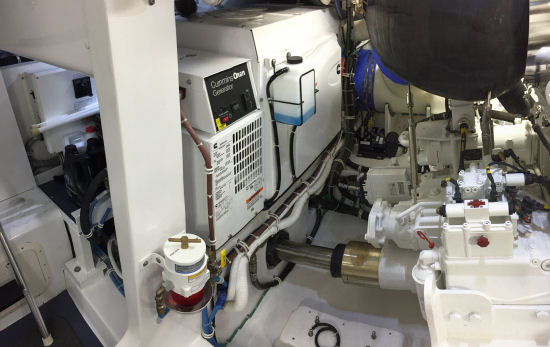
Transmissions are connected to the 4” shaft, then through dripless shaft seals to the Nibral propellers. Hatteras provides a prop removal tool to get the prop off the tapered Alloy 22 shaft with rounded keyways for reducing stress at the coupling ends. Stainless rails surround the engine and facilitate safety while conducting inspections when underway. The ceiling is well-insulated to prevent noise migration to the salon above. Lighting is both AC (fluorescent) and DC (LED). Engines are cooled with fresh water, reverse gears are electronically controlled and features neutral interlocks. Exhaust risers are supported with stainless supports and silencers are fitted.

Important Details.
There are individual thru-hulls for each engine and generator, all fitted with ball valves and strainers, double clamped. High-speed pickups are fitted for the watermaker, air conditioners and raw water pumps. A pair of 21.5 kW generators are located to the aft bulkhead and access to all filters and daily checkpoints for all mechanical gear is excellent. It’s a little snug trying to get to the outboard sides of the engines but it is doable when necessary, ideally when the engines have cooled.
Fuel Tankage
Feeding the engines is the work of a system of integrally-built, fiberglass fuel tanks that are actually part of the structural integrity and balance. Hatteras pioneered the use of integral fiberglass tanks. This is an optimal design because it lowers the CG and also forms a double bottom. A pair of 650-gallon (2,460 L) main tanks is positioned across the keel just ahead of the engine room. Another 840-gallons (3,180 L) is mounted on the centerline under the cockpit.
Electrical System
For the DC electrical system, two 24-V banks of heavy-duty batteries are mounted in fire retardant boxes. A 50/60hz charger is provided standard. The helm has a parallel switch to put the power of all batteries together for emergency starts. AC systems include two shore cords, one for 50 Amp and one for 100 Amp. Polarization transformers have boost functions. All AC receptacles have ground fault protection.
Performance
The Hatteras GT 70 has a LOA of 73’8” (22.45 m), a beam of 21’4” (6.50 m) and a draft of 5’ (1.53 m). With an empty weight of 120,000 lbs. (54,431 kg), half fuel, half water, and two people onboard, we estimated our test weight at 130,620 lbs. (59,248 kg). As noted above, we tested the GT 70 in 3’ to 5’ seas, a condition that undoubtedly slowed her down and raised her fuel consumption.
With a pair of 2600-hp MTU engines doing the heavy work, we reached a top speed of 41.0 knots at 2450 rpm. At that speed we were burning 262 gph resulting in a range of 422.5nm. Best economy was pretty subjective as the performance curve showed a steady curve all the way up to top speed. One therefore sets the throttle at the speed that will give the desired performance, likely one that is slated to keep the owner happy and get out in back in the quickest time possible. That said, we did find that dialing back to 2000 rpm and 33 knots (the top speed of many offshore convertibles) showed a fuel burn of 178 gph and a range of just over 500 nm.
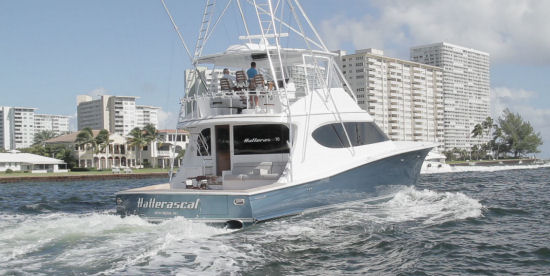
Handling
Now while those numbers are respectable, it’s even more impressive when one considers that we were running in 3’ to 5’ seas and getting those speeds. So as for the handling, it was unbelievable to see something this big move this fast through the snotty conditions we encountered. Where we could see other boats backing off from the pounding, the GT 70 was having none of that, and we sliced right through the square ones at 41 knots! It was impressive to see and if we hadn’t seen it with our own eyes… But see it we did and 41 knots in something this size in rugged offshore seas certainly got our attention. There are two ways that Hatteras accomplished this…beyond sheer horsepower (and lots of it), of course.
Weight Watchers
First, the engines are turning 5-bladed props through heavily geared transmissions. Prop tunnels reduce the angle of the 4” (10.16 cm) shafts so more of the thrust is directly pushing the boat forward rather than up. Weight is kept in check with constant measurements of every step in the production line to ensure that there was no excess material. The hull is resin-injected and a vacuum is pulled, getting a glass to resin ration of 60/40 which is optimal for weight and strength.
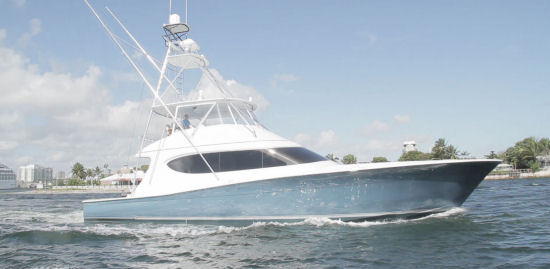
Solid Bottom.
Importantly, below the waterline, Hatteras does not use any coring material, something most builders these days do to save a lot of weight. While the advent of vinylester resin years ago stops water migration into the coring, Hatteras prefers to have a more puncture-resistant hull and for that reason sticks with solid fiberglass. It also helps lower the CG. For those who think that 120,000 lbs. (54,431 kg) is still pretty heavy, keep in mind that the former leader, the 68 Convertible weighed in at 140,000 lbs. (65,503 kg) and the effort starts to make more sense.
And Then There’s Design
Secondly, the design that makes the GT Series so popular is still intact. The Carolina bow flare and narrow entry that slices through waves and deflects spray so well, along with the ability to resist stuffing in large following seas, is easily seen. Aft, her wide beam and low deadrise at the transom provides an optimum planing surface and more stability in all conditions. The GT 70’s trademark tumblehome and sheer line that draws the eyes, also contribute to the makings of a good sea boat.
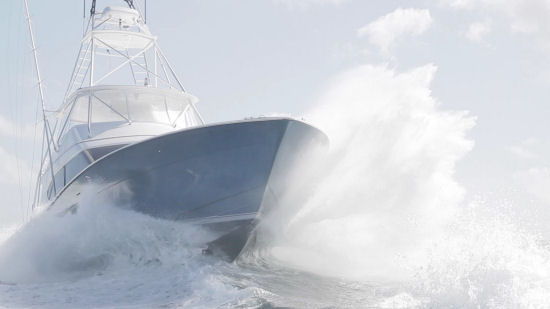
In fact, where we usually say that a boat performed better in this direction or that sort of sea, this boat took whatever we dished out and refused to show even a hint of displeasure with it. There was no bulkhead creaking or wracking sounds coming from below. No vibrating or hull shudder when hitting the big ones. Nothing. She was solid.
Putting Her to the TEST.
But we’re BoatTEST and we have to find something to complain about. So…if we took the seas at 2 points off the bow, we could get spray to come across the foredeck. And in the head sea, at full throttle, there were just a few instances of bouncing across the waves where our test driver’s GPS got bounced out of the drink holder and onto the deck. But, of course, this is more indicative of the sea conditions and the speed at which we were attacking them to see what would happen, than anything about the GT 70. We learned that she could take abuse.
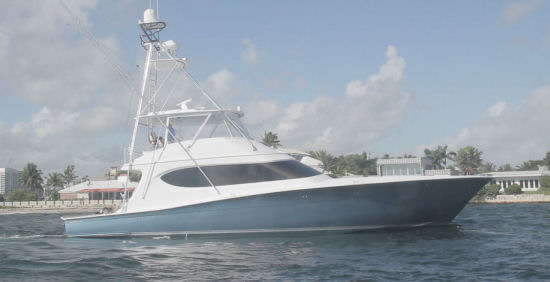
Pricing
Hatteras is hard-pressed to come up with pricing for this boat as each one is so highly customized according to an owners wishes, but some digging revealed a base of $4.5M, which was mentioned more than once. Of course when buying a yacht at this level, the customization that owners crave adds significantly to that base price and something along the lines of the Hatterascal will approach $6.5m. Not a hard concept to grasp, the upgraded engines are just short of $1m. But for those that long to be at the top of the sportfish pyramid, this will do the trick.
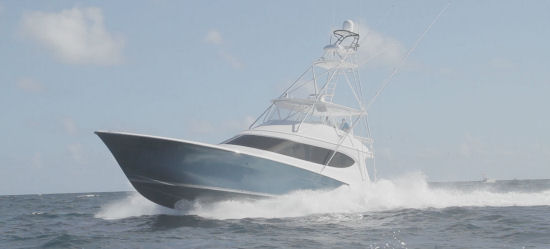
Observations
For Cruising, too.
Regular readers know that we have always been keen on large convertible as cruising boats as well as sport fishermen. Our reasons for this are many but include the fact that in general, a well-built convertible is a better sea boat than many motoryachts. Their CG is lower, their windage is less, and as pointed out above they are designed to take punishing conditions. We like the idea of being able to take off pretty much whenever we please without checking with the weatherman.
The Enclosed Flying Bridge.
The option of the enclosed flying bridge offers a lot of extra living and entertaining space for about a 5% premium, which is not bad, all things considered. That enclosed bridge becomes a “sky lounge” and most guests we know will be thrilled to go cruising from that vantage point. When it comes to entertaining, it is a fun place to hang out. We would definitely opt for the spiral staircase as it makes it easier for older people to go up and down, even at rest.
Less Horsepower.
We know that there is a clientele for these kinds of boats that only care about top speed and being the first out to the fishing grounds and the last back, but we’ve done enough tournament fishing to know that having a good captain with local knowledge is usually much more important than speed in a fishing tournament. We would go with the smaller 1950-hp MAN diesels.
Excellent Range.
Because she carries over 2,100 gallons (7,949 L) of fuel she can have prodigious range at reasonable speeds. And here is where she shines both for cruising and for getting to distant fishing grounds. At 21 knots she has a range of over 630 nautical miles, which means she can travel virtually anywhere in the Western Hemisphere and in-between she can make even the most distant fuel stops at planing speeds.
Superb Layout.
As we survey other boats in this class, which at first glance may appear to be the same, we were struck by how much more practical and user-friendly both the main deck and the accommodations layouts are. In the salon and galley there is simply more space and permits more and better utility. An example of the good flow and room in the galley is the clever optional table for lunch in the salon. Below, once again the 21’4” (6.50 m) beam makes life oh, so much more enjoyable, because there is simply more room in the guest staterooms, and the crew quarters can be isolated from the guest quarters.
Summary.
Clearly Hatteras Yachts under its new management has created a sea change at this venerable institution. Not only are the new owners investing millions of dollars in new tooling, but they also have brought in a new team that is dedicated to making its yachts modern-looking, utilizing all of the state-of-the-art technology and then building the yachts off with a fit-and-finish second to none. In our opinion, the new Hatteras GT 70 is a boat that the new team can be justly proud of.



